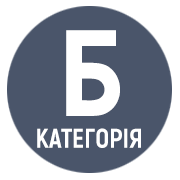SIMPLIFIED CRYPTOGRAPHY FOR SECURE VIBRATION PARAMETERS IN POST-PROCESSING OF 3D-PRINTED PARTS
DOI:
https://doi.org/10.32689/maup.it.2025.2.25Keywords:
3D printing, post-processing, vibration containers, lightweight cryptography, data encryption, mechanical grinding, polishingAbstract
In modern manufacturing, 3D printing technologies are gaining increasing popularity due to their ability to rapidly create complex and customized parts. However, to achieve high quality and meet industrial standards, 3D-printed parts require post-processing. Vibration containers are widely used for grinding, polishing, and other processing methods, improving the appearance and mechanical properties of products. This highlights the need to protect data generated during the vibration process, which is transmitted to central servers for analysis and management.The aim of this study is to develop a framework for a secure post-processing system for 3D-printed parts, which includes an encryption module based on lightweight ciphers to protect vibration parameters and other operational data.Methodology. This article proposes the use of lightweight cryptography to ensure the security of vibration parameters in the post-processing of parts printed using 3D printing methods. Lightweight cryptography allows for efficient data encryption with minimal resource consumption, which is critical for systems with limited computational capabilities. The paper discusses various post-processing methods – such as mechanical grinding and polishing – and their impact on the surface quality and compliance with standards. The cryptographic protocols used to protect data during its transmission from vibration containers to central servers are described in detail.The results can contribute to the advancement of 3D printing technologies and the creation of new post-processing methods that meet contemporary requirements for quality and information security.Scientific novelty. The use of the SPECK cipher has proven to be the optimal solution for resource-constrained systems, as it provides high encryption speed with low energy consumption, which is critical for microcontrollers and embedded systems used in post-processing operations.Conclusion. The proposed solutions provide reliable protection against unauthorized access and manipulation, improving overall manufacturing security and efficiency. Special attention is given to the integration of cryptographic methods into monitoring and control systems for vibration processes, ensuring high accuracy and reliability in data processing.
References
Fortune Business Insights. (n.d.). 3D printing market size, share & COVID-19 impact analysis. URL: https://www.fortunebusinessinsights.com/industry-reports/3d-printing-market-101902 (February 10, 2025)
Hozdić E. Characterization and Comparative Analysis of Mechanical Parameters of FDM-and SLA-Printed ABS Materials. Applied Sciences. 2024. № 14(2). P. 649. https://doi.org/10.3390/app14020649
Huang J., Qin Q., Wang J. A review of stereolithography: Processes and systems. Processes. 2020. № 8(9). P. 1138. https://doi.org/10.3390/pr8091138
Kafle A., Luis E., Silwal R., Pan H. M., Shrestha P. L., Bastola A. K. 3D/4D printing of polymers: fused deposition modelling (FDM), selective laser sintering (SLS), and stereolithography (SLA). Polymer. 2021. № 13(18). P. 3101. https://doi.org/10.3390/polym13183101
Karakurt I., Lin L. 3D printing technologies: techniques, materials, and post-processing. Current Opinion in Chemical Engineering. 2020. № 28. P. 134–143. https://doi.org/10.1016/j.coche.2020.04.001
Kopar M., Yildiz A. R. Experimental investigation of mechanical properties of PLA, ABS, and PETG 3-d printing materials using fused deposition modeling technique. Materials Testing. 2023. № 65(12). P. 1795–1804. https:// doi.org/10.1515/mt-2023-0202
Kristiawan R. B., Imaduddin F., Ariawan D., Ubaidillah Arifin, Z. A review on the fused deposition modeling (FDM) 3D printing: Filament processing, materials, and printing parameters. Open Engineering. 2021. № 11(1). P. 639–649. https://doi.org/10.1515/eng-2021-0063
Lim J. X. Y., Pham Q. C. Automated post-processing of 3D-printed parts: artificial powdering for deep classification and localisation. Virtual and Physical Prototyping. 2021. № 16(1). P. 1–14. https://doi.org/10.1080/17452759.2021.1927762
Pavlenko P., Teslia I., Khlevna I., Yehorchenkov O., Yehorchenkova N., Kataieva Y., Khlevnyi A., Veretelnyk V., Latysheva T., Kubiavka L. Development of a concept of combined project-production activities planning using digital twins. Eastern-European Journal of Enterprise Technologies. 2024. № 5 (131(3)). P. 6–17. https://doi.org/10.15587/1729-4061.2024.311751
Rashidi B. Flexible structures of lightweight block ciphers PRESENT, SIMON and LED. IET Circuits, Devices & Systems. 2020. № 14(3). P. 369–380. https://doi.org/10.1049/iet-cds.2019.0363
Rashidi B. High-throughput and flexible ASIC implementations of SIMON and SPECK lightweight block ciphers. International Journal of Circuit Theory and Applications. 2019. № 47(8). P. 1254–1268. https://doi.org/10.1002/cta.2645
Raza A., Markovic N., Wolf T., Romahn P., Zinn A. H., Kolossa D. Glass Container Fill Level Measurement via Vibration on a Low-Power Embedded System. In 2023 IEEE International Conference on Omni-layer Intelligent Systems (COINS), July 2023, pp. 1–6.
Rozlomii I., Yarmilko A., Naumenko S. Analysis of Information Security Issues in Balancing Multiple Independent Containers on a Single Server. CEUR Workshop Proceedings. 2023.Vol. 3628. P. 450–461. URL: https://ceur-ws.org/Vol-3628/paper26.pdf
Rozlomii I., Yarmilko A., Naumenko S. Data security of IoT devices with limited resources: challenges and potential solutions. CEUR Workshop Proceedings. 2024. Vol. 3666. P. 85–96. URL: https://ceur-ws.org/Vol-3666/paper13.pdf
Symoniuk V., Denysiuk V., Lapchenko Y., Kaidyk O., Ptachenchuk V. About Trimming Processes of Parts in the Shock- Impulse Load of Vibrobunker. In Grabchenko’s International Conference on Advanced Manufacturing Processes, September 2019. Cham: Springer International Publishing, 2019, pp. 321–330.
Symonyuk V. P., Ptashenchuk V. V., Tymoshchuk A. A. To analysis of the technical state of the equipment for manufacturing parts using 3D printing. Promising technologies and devices. 2022. № 21. P. 113–118.
Voievodin Y., Rozlomii I. Application Security Optimization in Container Orchestration Systems Through Strategic Scheduler Decisions. CEUR Workshop Proceedings. 2024. Vol. 3654. P. 471–478. URL: https://ceur-ws.org/Vol-3654/short16.pdf
Xu X., Goyanes A., Trenfield S. J., Diaz-Gomez L., Alvarez-Lorenzo C., Gaisford S., Basit A. W. Stereolithography (SLA) 3D printing of a bladder device for intravesical drug delivery. Mater Sci Eng C Mater Biol Appl. 2021 Jan; 120:111773. https://doi.org/10.1016/j.msec.2020.111773. Epub 2020 Dec 4. PMID: 33545904.
Downloads
Published
How to Cite
Issue
Section
License
Copyright (c) 2025 Інна РОЗЛОМІЙ, Сергій НАУМЕНКО, Володимир СИМОНЮК, Віталій ПТАШЕНЧУК, Віталій ЗАЖОМА

This work is licensed under a Creative Commons Attribution 4.0 International License.





